What is Demand?
The demand for anything, at a given price is the amount of it which will be bought per unit of time at the price.
Table of Content
- 1 What is Demand?
- 2 Definitions of Demand
- 3 Essentials of Demand
- 4 Determinants of Demand
- 5 Classifications of Demand
- 6 Law of Demand
- 7 Assumptions
- 8 Exceptions to the Law of Demand
- 9 Elasticity of demand
- 10 Types of Elasticity of Demand
- 11 Determinant factors of elasticity of demand
- 12 Price Elasticity of Demand
- 13 Income Elasticity of Demand
- 14 Cross Elasticity of Demand
- 15 Methods of calculating elasticity of demand
- 16 Importance of elasticity of demand
The quantity of a commodity that a consumer is willing to buy and is able to afford, given prices of goods and consumer’s tastes and preferences is called demand for the commodity.
Definitions of Demand
Essentials of Demand
An Effective Desire
Effective desire means that there must be a desire backed by the ability and willingness to pay. Thus, there are three essentials of an effective desire.
- The person must have a desire to have a particular commodity.
- He must have adequate resources to purchase that commodity.
- He must be ready to spare these resources for that commodity.
A Particular Price
A statement regarding the demand of a commodity without reference to its price is of no use. For example, to say that the demand of television sets is 10,000 is useless, unless it is said that the demand of TV sets is 10,000 at a price of Rs. 4,000 each.
A Particular Time
Demand should refer to a particular time. For example, it is an incomplete statement to say that the demand of coolers is 4,000 at the price of Rs. 1,800 each. The statement should be altered to say that the demand of coolers during summer is 4,000 at the price of Rs. 1,800 each.
A Definite Place
The demand should refer to a particular market. For example, Annual demand of coolers in Delhi is 4,000 at a price of Rs.1800.
Thus, the demand of a commodity is an effective desire that explains the quantity of a commodity that will be purchased at a particular price in a particular market during a particular period.
Demand of Maruti Car
If everybody wants to own a Maruti car, it does not mean that the demand of Maruti car in the market is very high because the desire to own a particular commodity cannot be its demand. it can become a demand only when desire is backed by the ability and willingness to pay.
The desire of Maruti car is not sufficient to increase its demand. The person‘s desire to own a Maruti car should be backed by adequate resources to purchase it and he/she must be ready to spare these resources on its purchase.
Determinants of Demand
Price of the Commodity
The most important factor affecting demand is the price of the commodity. The amount of a commodity demanded at a particular price is precisely called price demand.
The relation be tween price and demand is called the Law of Demand. it is not only the existing price but also the expected changes in price, which affect demand.
Income of the Consumer
The second most important factor influencing demand is consumer‘s income. in fact, we can establish a relation between the consumer income and the demand at different levels of income, commodity demand goes up when income rises and down when income falls. However, in case of Giffen goods the relationship is the opposite.
The demand for a commodity is affected by the changes in prices of the related goods also. Related goods can be of two types:
- Substitutes :These can replace each other in use; for example, tea and coffee are substitutes. The change in price of a substitute has effect on a commodity‘s demand in the same direction in which price changes. The rise in price of coffee shall raise the demand for tea.
- Complementary Goods: These are those, which are jointly demanded, such as, pen and ink. in such cases, complementary goods have opposite relationship. if price of pens goes up, their demand is less because of which the demand for ink is also less.
Change in tastes of the Consumers
The amount demanded also depends on consumer‘s taste. Taste includes fashion, habit, customs, etc. A consumer‘s taste is also affected by advertisement. if the taste for a commodity goes up, its amount demanded is more even at the same price. This is called increase in demand. The opposite is called decrease in demand.
Amount of Wealth
The amount of a commodity is also affected by the amount of wealth as well as its distribution. The wealthier are the people, higher is the demand for normal commodities. If wealth is more equally distributed, the demand for necessities and comforts is more. On the other hand, if some people are rich, while the majority is poor, the demand for luxuries is generally higher.
Increase in Population
Increase in population increases demand for necessities of life. The composition of population also affects demand. Composition of population means the proportion of young and old and children as well as the ratio of men to women. A change in composition of population has an effect on the nature of demand for different commodities.
Government Policy
Government policy affects the demand for commodities through taxation. Taxing a commodity increases its price and the demand go down. Similarly, financial help from the government increases the demand for a commodity while lowering its price.
Consumers Expectations Regarding the Future
If consumers expect changes in price of a commodity in future, they will change the demand at present even when the present price remains the same. Similarly, if consumers expect their incomes to rise in the near future they may increase the demand for a commodity just now.
Climate and Weather of Area
The climate of an area and the weather prevailing there has a decisive effect on consumer‘s demand. In cold areas, woollen cloth is demanded. During hot summer days, ice is very much in demand. On a rainy day, ice cream does not have a great demand.
Business Conditions
The level of demand for different commodities also depends upon the business conditions in the country. If the country is passing through boom conditions, there will be a marked increase in demand. On the other hand, the level of demand goes down during depression.
Classifications of Demand
Important bases of classification, of demand are nature of goods, duration of consumption of a commodity, period of demand, nature of use of the commodity, number of consumers of a commodity, supplies of commodity etc. important classifications of demand are as under:
- Derived Demand and Autonomous Demand
- Industry demand and company demand
- Total market demand and market segment demand
- Short-term demand and long-term demand
- Consumers goods demand.
Derived Demand and Autonomous Demand
- Derived Demand
It is the demand for a product associated with the demand of some other product.
For example, the demand of bricks, cement, iron and so on is a derived demand because it is directly related with the construction of buildings. Similarly, the demand for petrol, diesel, brake-oil and mobile oil etc.
Derived demand facilitates forecasting when proportion of two products is fairly fixed. For example, if the demand of auto-vehicles decreases, the demand of tire, tube, petrol, diesel, etc. is bound to decrease.
When demand of a product is independent and not associated with the demand of any other product, it is called autonomous demand.
- Autonomous Demand
For example, the demand of house, clothes, cycle, scooter, car, food grains, fruits, vegetables, etc., is autonomous and quite independent as these goods are meant for direct consumption by consumer.
The distinction between derived demand and autonomous demand is only a matter of degree and not of quantity.
For example, the demand of clothes is independent but if the prices of raw material being used in the manufacture of cloth decrease, it will cause a decline in the price of cloth and due to the decline in prices of raw materials, demand of cloth will increase.
Industry Demand And Company Demand
Industry Demand means the total demand for the products of all the units of a particular industry. it is the total demand for the products of a particular industry. In industry, it means a group of firms producing same products or the products that are close substitute for each other.
Thus, industry demand includes the demand for a particular product and demand for the products that are close substitute for each other.
For example, the demand of motor bikes in the country will be called industry demand.
Company demand
company demand means the demand for the products of a particular firm.
For example, the demand of Bajaj Pulsar motorbike is a company demand. Similarly, the demand of Birla White cement is a company demand.
Individual Demand and Market Demand
Market share of demand is the part of the total demand of a product or service product by an industry, which has been captured by a particular company or enterprise of that industry. it establishes the relationship of demand of the goods produced by an individual company with the total demand of that industry.
While company demand expresses the quantity of demand in absolute terms, market share of demand expresses the demand of a company in relative terms.
Total Market Demand and Market Segment Demand
Total market demand means the total demand of a particular product in the whole market. it includes the demand of a product by all the consumers of all the areas. When the market of a product is divided into different segments based on geographical area or consumers, the demand of each such segment is called market segment demand.
The concept of total market demand plays an important role in forecasting the total demand for a product during a particular period. The concept of market demand is important for determining the pricing policy, sales promotion policy, distribution policy etc., for the individual segments.
Short-Term Demand and Long-Term Demand
Analysis of demand based on time is useful from the managerial point of view. Based on time, analysis of demand can be of two types — short-term demand and long-term demand. Short-term demand is immediately affected by a change in the price of product or service and in the income of many consumers.
On the other hand long-term demand of a product or service is the expected demand of that product or service in future.
For example, if the price of cooking gas falls, its demand will increase in short-term because the consumers will prefer to use cooking gas in place of other sources of fuel.
Long-term demand will increase as those who were using any other source of energy, will start using cooking gas. While projection of short-term demand helps in preparing the plans of production, purchases, work force, inventory, etc.
Consumer goods and capital goods
The nature of demand of producers goods and consumers goods is fundamentally different. While the demand of consumers‘ goods is influenced by the needs, tastes, fashion, income and preferences of consumers, the demand.
Of producers‘ goods is influenced by the demand of consumers‘ goods, possibilities of industrial development, profitability of industries, level of activity of industries and government policy etc.
Sometimes It is difficult to differentiate between consumers‘ products and producers‘ products because some products may be called both consumers‘ products as well as producers‘ products, such as sugar, coal, cotton etc. These products are consumers‘ products when used in a family.
Law of Demand
The greater the amount to be sold, the smaller the price at which it is offered must be in order for it to find purchasers.
Dr. Alfred Marshall in his book The Principle of Political Economy has stated the law of demand, which explains the day-to-day experience in a common person’s life.
According to this law, if other conditions remain constant, with increase in price, demand for the commodity will diminish. This is because at higher price the consumer gets less utility. While, with decrease in price, the consumer will derive more utility and therefore, demand for a commodity will have rising tendency.
If the price of the good increases, the quantity demanded decreases, while if price of the good decreases, its quantity demanded increases”. This law can also be explained with the help of demand schedule and demand curve.
Demand Schedule
It is the table showing how much will be demand at different price levels. Table 4.1
| Price Rs. 1 2 3 4 5 |
| Units Demanded 50 40 30 20 10 |
Demand Curve
When we represent the demand schedule geometrically i.e. in the form of a diagram, we get demand curve which has negative slope because of inverse relationship.


Form the above discussion, we can mention the following important points:-
In the diagram, X‘ axis represents demand for the commodity; while Y‘ axis represents price of the commodity. D is the demand curve. When price of the commodity is P1, demand for the commodity is D1. When price rises by P2 amount (to OQ), demand for the commodity falls by D2 amount ( to OK).
On the other hand, when price of the commodity falls by P1 amount (i.e. to OP) the demand for the commodity rises by D1 amount (i.e. to OM). Thus, there is ‘inverse relation’ between price and demand.
From the above discussion, we can mention the following important points
- There is inverse relationship between price and demand.
- The demand curve has negative slope.
- Demand curve slopes downward, from left to right.
Assumptions
- This law will be applicable only when certain conditions are constant.
- The level of income of a person must remain constant.
- Tastes and habits of the people do not change.
- Prices of substitute and complementary goods and services remain constant.
- Quality of the product remains constant.
- Population remains constant.
Exceptions to the Law of Demand
Giffen‘s Paradox: it was for the first time, the British economist Prof. Giffen showed the direct relationship between price and demand for inferior goods.


In case of inferior goods, if price decreases the demand for those goods decrease and with increase in price demand for inferior goods increase.
- Luxurious commodities: It is general experience that although prices of luxurious commodities are increasing, their demand is also increasing. Example: Gold
- Necessities : In case of necessary commodities, law of demand is not applicable. Some commodities like salt are so much necessary that with change in price of these commodities, their demand does not change.
- Fashionable Goods : In case of fashionable goods, law of demand is not applicable. During the period of fashion even though price of the commodities increases, its demand is also increasing. On the other hand, when the fashion becomes out date even though its price decreases, demand is also decreases.
Extension and Contraction in Demand/Variation in Demand
According to law of demand, there is inverse relationship between price and demand. When there is change in demand due to change in price, other factors being constant, there is extension or contraction in demand.

In the above diagram, X‘ axis represents demand, while Y‘ axis represents, price. When price increases from OP to OQ, demand for the commodity contracts From OM to OK. If price decreases from OQ to OP, demand for the 61 commodity extends from OK to OM.
Thus other factors being constant, if price increases, demand for the commodity contracts and if price decreases demand for the commodity extends.
Increase and Decrease in Demand/Changes in Demand
At constant price if other factors changed, it results into increase or decrease in demand.
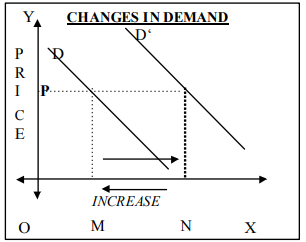
In the above diagram price of the commodity is constant at OP. However, if other factors like, income, demand for the commodity will also increase from OM to ON. On the other hand, if income decreases demand for the commodity will also decrease from ON to OM.
Thus, when price is constant, if other factors change, it results into increase or decrease in demand. Thus, price being constant, with change in other factors, if demand falls, it is called decreases in demand; &if demand rises, it is called increase in demand.
Elasticity of demand
Alfred Marshall‘s law of demand explains the inverse relationship between price and demand.The theory of utility explains why the relationship is inverse. The theory of utility explains why the relationship is inverse. However, with increase in price, by how much, amount demanded will change is explained with the help of elasticity of demand.
Meaning of Elasticity of Demand
Elasticity of demand is a demand relationship in which any given percentage change in price will result in a larger percentage change in the quantity demanded.The more demand expands or contracts after a price change the greater the elasticity.
For example, if a ‘good’ has a close substitute such as chicken substituted for steak the steak is ‘elastic’.
Definition of Elasticity of Demand
The concept of elasticity of demand can be defined as “the degree of responsiveness of demand to given change in price of the commodity demand”. This means amount through which demand will change with given change in price, is explained with the help of elasticity of demand.
Elasticity of demand can be calculated with the help of following formula:


Thus, elasticity of demand is the ratio of percentage change in demand to percentage change in price.
The degree of elasticity of demand depends upon the nature of commodity. Demand for necessary commodity is less elastic while demand for luxurious commodities is more elastic.
Types of Elasticity of Demand
- Inelastic demand
- Less Elastic Demand
- Unitary Elastic Demand
- More Elastic Demand
- Perfectly Elastic Demand
Inelastic Demand
Demand for the commodity is said to be inelastic when even though price of the commodity changes, demand for the commodity does not change.This means that in spite of change in price, demand for the commodity is constant. This can be explained with the help of following diagram.

In the above diagram, D‘ is the demand curve, which represents inelastic demand. Even though price changes from OP to OQ or from OQ to OP, demand for the commodity is same i.e. OM. Thus in this case demand is not at all responding to change in price and i.e. why elasticity of demand is equal to zero (el = 0).
Less Elastic Demand
Demand for the commodity is said to be less elastic when the degree of change in demand is less than the degree of change in price i.e.amount of change in price is more while amount of change in demand is less as compared to change in price. This is called as less elastic demand‘, which can be explained with the help of following diagram.
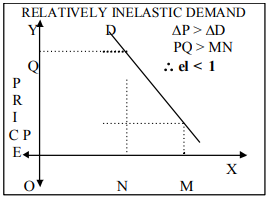
In the diagram, D is the Demand curve that shows less elastic demand. The change in price i.e. PQ is greater than the change in demand i.e. MN. This means that the response of demand to change in price is less that is why it is considered as less elastic demand, which is always less, then one, as in the case of necessary commodities.
Unitary Elastic Demand
Demand for the commodity is said to be less elastic when the degree of change in demand is less than the degree of change in price i.e. amount of change in price is more while amount of change in demand is less as compared to change in price. This is called as iless elastic demand‘, which can be explained with the help of following diagram.

In the diagram, D is the demand curve representing unitary elastic demand. Demand for the commodity changes by MN amount, which is exactly equal to change in, price i.e. PQ. Thus, the response of demand is equal to change in price i.e. PQ. Thus, in this case elasticity in demand is equal to one.
More Elastic Demand
When responsiveness of demand is more in relation to change in price it is considered demand that is more elastic. in this case, change in demand is more related to change in price. This can be explained with the help of a diagram.
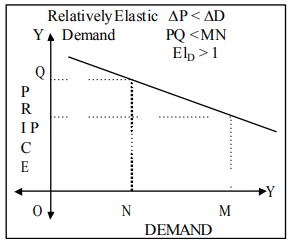
In the above diagram, demand curve is more flat representing more elastic demand. Change in price from P to Q results in change in demand from M to N but change in price is less than change in demand that is why it is considered more elastic demand. it is always greater than one (El > 1).E.g. luxurious commodities.
Perfectly Elastic Demand
When very minute change in price results into drastic change in demand, it is considered as perfectly elastic demand curve. This can be explained with the help of the diagram.

In the above diagram, D curve represent perfectly elastic demand. Little change in price will result into change in demand, which cannot be represented with the help of some demand curve. Here, elasticity of demand is infinite.
Determinant factors of elasticity of demand
The following are the determining factors:
Urgency of wants
- If the desire for a commodity were very strong, then the demand would be inelastic e.g. habituated goods like cigarettes.
- Less urgent the want, greater the elasticity of demand e.g. eating in a posh restaurant occasionally.
Availability of substitutes
- Necessities (e.g. basic food, salt, etc.) have a relatively inelastic demand.
- Luxurious goods (like diamonds, jewels, VCRs, etc.) have a relatively elastic demand.
Availability of substitutes
- If no substitutes were available then the demand would be inelastic, e.g. chalk for blackboards have no substitutes.
- If substitutes were available, then the demand would be elastic, e.g. tea and coffee.
Number of uses
- More restrictive the use of a commodity, lesser the degree of elasticity · Commodities with multiple purposes will have a greater elasticity e.g
- coal or electricity or wood because consumers would prioritise their uses and satisfy only the most important ones first and forego the less important ones.
Proportion of income spent
- Lesser the proportion of the income spent, lesser the degree of elasticity e.g. the purchase of cereals by the middle-income group.
- Greater the proportion of the income spent, greater the degree of elasticity, e.g. the purchase of luxuries by the middle-income group.
Price level of the commodity
- If the price of the commodity were reasonably low, then the degree of elasticity would be less e.g. the demand for bread.
- If the price of the commodity is high, then the degree of elasticity would be high e.g. luxuries.
Durability of the commodity
Greater the durability of the commodity, lesser would be the elasticity of demand e.g. TVs, fridges, stereos . Lesser the durability of the commodity, greater would be the elasticity of demand e.g. vegetables, chalks.
Element of time
In the short run the demand for a commodity will be relatively inelastic, e.g. demand for perishable goods. The demand for a commodity will be relatively elastic because consumers will be able to shift from the use of one commodity to a substitute commodity, since with the passage of time, substitutes will be discovered or invented e.g. people could shift from the use of the expensive china-ware to the cheaper plastic-ware.
Price Elasticity of Demand
Price elasticity of demand measures the percentage change in quantity demanded caused by a percent change in price. As such, it measures the extent of movement along the demand curve. This elasticity is usually negative and is usually expressed in terms of absolute value.
If the elasticity is greater than one, demand is said to be elastic; between zero and one demand is inelastic, and if it equals one, demand is unit-elastic.
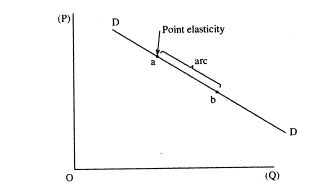
Price Elasticity is measured as:

Where, P1 is initial price, P2 is new price, Q1 is initial demand and Q2 represent new demand.
DP = P1 -P2
DQ=Q1-Q2
Income Elasticity of Demand
The ratio of proportionate change in the quantity demanded of the commodity to a given proportionate change in the income of the consumer.

The income elasticity of demand for a commodity shows the extent to which a consumer‘s demand for that commodity changes because of the changes in his income. it is defined as “The ratio of proportionate change in the quantity demanded of the commodity to a given proportionate change in the income of the consumer.
Like Price Elasticity of Demand, we can classify income Elasticity of Demand as follows:
Negative income Elasticity of Demand
Elasticity of Demand: This refers to the situation where a given increase in the consumer‘s income actually results in a fall in the quantity demanded This is shown graphically in the figure above as (A).
Zero income Elasticity of Demand (perfectly income elastic Demand)
This refers to the situation where a given increase in the consumer‘s income does not result in any increase in the quantity demanded. This is shown graphically in the figure above as (B).
Relatively income inelastic Demand
This refers to the situation where a given increase in the consumer‘s income brings about a less than proportionate increase in the quantity demanded. This is shown graphically in the figure above as (C).
Unitary income Elasticity of Demand
This refers to the situation where given increase in the consumer‘s income brings about a proportionate increase in the quantity demanded. This is shown in graphically in the figure above as (D).
Relatively income Elastic Demand
This refers to the situation where a given increase in the consumer‘s income brings about a more than proportionate increase in the quantity demanded. This is shown graphically in the figure above as (E).
Cross Elasticity of Demand
The relationship between two commodities can be substitutive, complementary or even neutral. in the context of the first two relationships, the term cross elasticity could be defined as.
The ratio of the proportionate change in the quantity demanded of commodity X to a given proportionate change in the price of the related commodity Y.
Substitutes
If the two commodities are substitutes of each other, then a rise in the price of Y (assuming that the price of X is constant), will bring about an increase in the demand for X, because the consumers will now substitute the dearer good Y with the now cheaper good X.
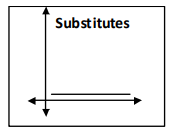
Hence, the cross demand curve will have a positive slope as shown above. The cross elasticity is high in the case of close substitutes and is low in the case of poor substitutes.
Complements
If the two commodities are complements of each other, then a rise in the price of Y (assuming that the price of X is constant), will bring about a decrease in the demand for X. This happens because the consumer will drop his demand of the dearer good Y and so consequently also drop his demand for goods Y‘s supporting commodity viz., good X.

Hence, the cross demand curve will have a negative slope as shown above. The cross elasticity is high in the case of close complements and is low in the case of poor complements. Thus, the cross elasticity in the case of jointly demanded commodities is negative.
Neutral Goods
If the two commodities are not related to each other at all, then cross elasticity of demand will be zero. A change in the price of commodity will not affect the quantity demanded of the other.

Hence, demand curve will be parallel to the y-axis as shown above.
Methods of calculating elasticity of demand
Elasticity of demand means the degree of responsiveness of demand to given change in price. Elasticity of demand helps to decide production policies.
Therefore, by using three different methods elasticity of demand is measured.
Ratio Method
While calculating elasticity of demand through this method we make use of demand schedule where we considered two factors – price and demand.
According to this method, elasticity of demand is the ratio of percentage change into demand and price. Thus, with the help of formula we can derive elasticity of demand as follows:

If the value of this formula is equal to one, it will be considered unitary elastic demand. If the value of this formula is more than one, it will be considered ‘more elastic demand’. if the value is less than one, it is considered ‘less elastic demand’. With the help of this method, we can measure exact value of elasticity of demand.
Expenditure Method
While calculating elasticity of demand through this method we do not consider demand for the commodity. in this method, we consider two factors those are price of the commodity and expenditure incurred on the commodity.
Thus, even though we do not know demand schedule, then also we can calculate elasticity of demand by considering price and expenditure on the commodity. According to this method: If in spite of change in price expenditure on the commodity remains constant, it represents unitary elastic demand.
If there exists a direct relationship between price and expenditure, it will be considered ‘less’ elastic demand. · If there exists an inverse relationship between price and expenditure, it represents ‘more elastic demand’.
This can be explained with the help of the following diagram:
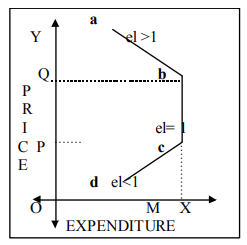
In the diagram, iX‘ axis represents expenditure on the commodity and iY‘ axis represents price of the commodity. ‘AB’, part of the expenditure curve represents inverse relation between price and expenditure. This shows ‘more elastic demand’.
BC part of the expenditure curve indicates that in spite of change in price by PQ, expenditure on the commodity remains constant at OM. it represents unitary elastic demand. CD part of the expenditure curve indicates direct relation between price and expenditure, which shows less elastic demand.
Point Method
The demand schedule if we want to calculate elasticity of demand through ratio or expenditure method. However, if only demand curve is given, we make use of point method for calculating elasticity of demand.
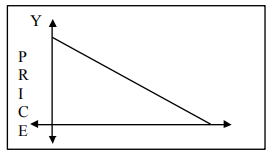
In this method, we use following formula:

In the above diagram on MP, demand curve iA‘ is the midpoint representing same distance from both axes. At point iA‘, elasticity of demand is equal to one, which means it is unitary elastic demand. Every point on iAM‘ part of the demand curve represents ‘less elastic demand’ while every point on IAP‘ part of the demand curve represents ‘more elastic demand’.
Importance of elasticity of demand
The study of elasticity of demand can be discussed in two parts.
Theoretical importance
From the theoretical point of view, by studying the elasticity of demand, we know that price variations if commodities at different occasions or time affect the demand of persons of different classes of society
Practical importance
From practical point of view, the study of elasticity of demand is important for monopolists, traders, industrialists and finance minister of a country.
Importance to Monopolist
By studying the elasticity of demand, a monopolist can decide the price at which the demand for his commodity will be maximum and the price at which by selling his commodity he will get maximum profit. The general rule is that:
If the demand for commodity is inelastic or less elastic, the monopolist can increase its price and earn more profit because as the demand is inelastic the demand will not decrease though the price has increased.
On the other hand, if the demand is highly elastic the monopolist will have to keep low price and he will have to increase production because in such conditions, more units of the commodity would be sold at low price and his total profit is maximum. It is not advantageous for the monopolist to keep high price of that commodity whose demand is elastic or highly elastic.
Importance to Traders and industrialists
The study of elasticity of demand is also important for traders and industrialists. The general rule is that:
If the demand for the commodity is inelastic or less elastic, the traders and industrialists can keep high price because though the price is high the demand will not be less because the demand is inelastic.
On the other hand, if the demand is elastic or highly elastic the traders and industrialists will have to keep low price and sell more or produce more.
Importance to Finance Minister
The finance minister imposes tax on different commodities. While imposing tax on a commodity the finance minister has to take into consideration the nature of the elasticity of demand for a commodity. When the tax is imposed on it, the general rule is that:
If the demand for a commodity is inelastic or less elastic, the finance minister can impose tax on that commodity because though its price increases due to the imposition of tax its demand will not decrease because its demand is inelastic. The government will not lose the revenue from tax.
On the other hand, if demand of a commodity is elastic or highly elastic the finance minister will not be able to impose too much tax on that commodity because as demand is elastic the demand will fall because its price increases due to the imposition of tax. in such condition, the government will lose the revenue from tax.